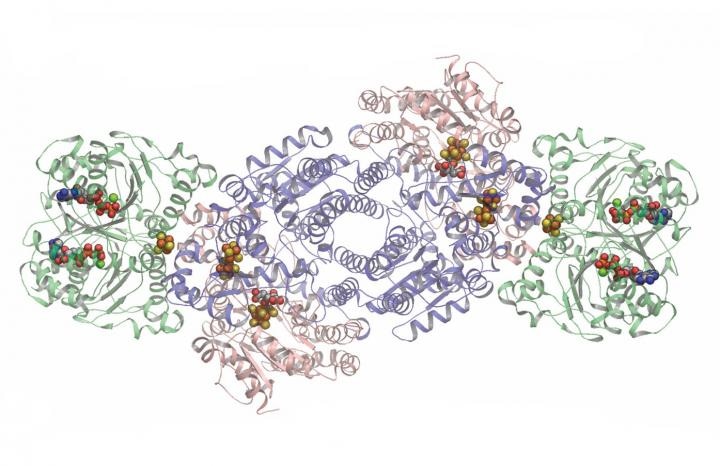Oct 5 2016
 Two copies each of three proteins (in different colors) make up the nitrogenase complex. In this image, the spots where chemistry happens are highlighted as stick-and-ball molecules. (Credit: Simone Raugei/PNNL)
Two copies each of three proteins (in different colors) make up the nitrogenase complex. In this image, the spots where chemistry happens are highlighted as stick-and-ball molecules. (Credit: Simone Raugei/PNNL)
Nitrogen is vital for life, and in nature the chief source of nitrogen is in the form of gas found in earth’s atmosphere. This gas does not react easily with other elements. Certain types of specialized bacteria are capable of converting nitrogen molecules in the air into ammonia so that it can be used to create proteins, which are the building blocks, power plants and machines of cells.
Chemists have previously created a method of producing ammonia industrially using atmospheric nitrogen; however this man-made method consumes plenty of energy. Understanding the way bacteria fasten nitrogen molecules into ammonia would help to save energy in industrial processes, such as those used to manufacture fertilizer. Researchers are analyzing the bacterial enzyme behind this, a complex enzyme known nitrogenase.
In a new study, a team of researchers from the Department of Energy's Pacific Northwest National Laboratory (PNNL) obtained vital information regarding the manner in which nitrogenase creates ammonia. The findings have been published in the Proceedings of the National Academy of Sciences.
We propose that the enzyme works as a two-stage engine where the two parts work nearly synchronously. All this is achieved by complex communication between the two halves.
Simone Raugei, Computational Chemist, PNNL
It has long been a mystery how two identical halves of nitrogenase functioned together, but these findings expose the fact that they cooperate in an efficient manner. One half is working to break down a nitrogen molecule, shifting some of the pieces in place to create ammonia, while the other half is waiting for the first to finish part of its function.
The authors theorize that the second half begins on a new nitrogen molecule while the first half completes the later steps, the two going back and forth in sync until an entire nitrogen molecule is broken down and rebuilt into ammonia.
Ammonia Machine
The working nitrogenase is essentially a complex of several metals and proteins, along with energy-storage molecules known as ATP to power the entire thing. The complex has two equal halves. Either of these can turn molecular nitrogen to ammonia, molecules that possess one nitrogen atom bonded to three hydrogen atoms.
Although researchers are aware of what the complex looks like, several of the details of how it really functions are yet to be resolved.
The nitrogenase, burning through ATP, integrates atmospheric nitrogen with electrons and protons to fabricate ammonia molecules. The components on either side of nitrogenase perform the same thing: some symbolically unbolt the electrons keeping the atoms together; others shift things around and into place, and others place the pieces into ammonia. The halves are alike but symmetrical, positioned in relation to each other..
The enzyme generates two ammonia molecules and one hydrogen molecule as a byproduct for each nitrogen molecule that is broken down. This method requires eight electrons and eight protons, contributed by other components in the bacterium. Each half shifts only one electron at a time, so it has to repeat the action eight times to make two ammonia molecules.
For a long time, several researchers believed that the two symmetrical halves took up electrons separately. However lab experiments indicate that may not be the case.
A kinetic model where the two halves work independently didn't match new data collected by our laboratories.
Lance Seefeldt, PNNL
If the two halves were not autonomous, what was happening? The team, including Seefeldt at PNNL and Utah State University, Raugei, Brian Hoffman at Northwestern University, Edwin Antony at Marquette University and eight other researchers, planned to find out.
The team prepared three potential ways the enzyme could function, with the plan to see which one ideally matches experimental data. One way was the widely accepted version - both sides worked completely autonomously without interfering with each other. In another way, only a single side worked at a time, while the other side was fully shut down until the first side was finished. The third way functioned somewhere in between.
Each technique made certain predictions about the variety of steps in the chemical reactions. Then the team conducted the reactions in the lab and analyzed the findings.
This One's Just Right
They discovered that the quantity of byproducts created in the experiments was about half anticipated if the two sides worked fully independently, so they eliminated the first model. And the nitrogenase used up a lot of ATP for only a single side to be working at a time; therefore they eliminated the second model.
The data ideally worked with the third model. In this, one side performed a chemical reaction and partially curbed the activity on the other side. To visualize what was happening, the team analyzed the molecular specifics of the nitrogenase complex using a computer. They noticed something quite fascinating in their computer simulation.
When one side shifted an electron via the nitrogenase machine, the complex changed in shape. Since the sides are symmetrical, shifting one side up shifts the other side down. By doing this, different parts of the machine are positioned for different chemical reactions.
Large-scale (for a protein) shape modifications like this are a general process for proteins to be turned off and on, but it has not frequently been seen in nitrogenase catalysis, said Raugei.
Long-distance communication as a way to regulate electron movement is unusual in catalysis.
Simone Raugei, Computational Chemist, PNNL
Going forward, the team hopes to generate a highly precise computer-based simulation to better study how nitrogenase produces ammonia.
This research was supported by the Department of Energy Office of Science and the National Institutes of Health.
Rocking Reaction: Bacterial Nitrogenase
Video Credit: PNNL S&T/Youtube.com